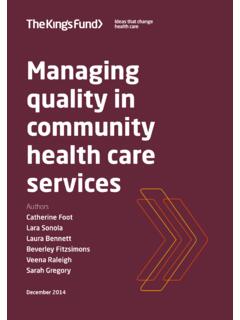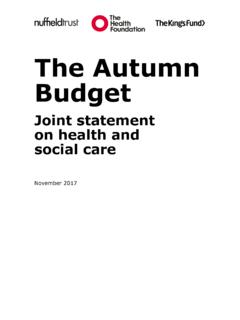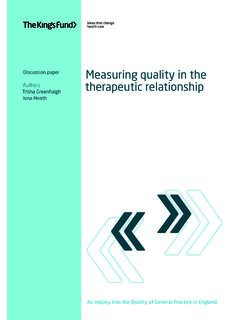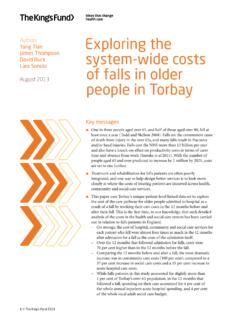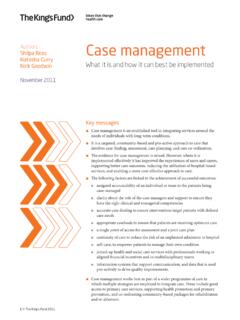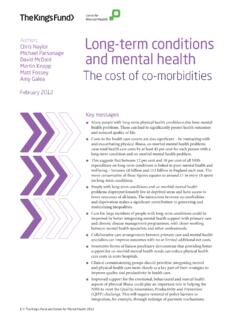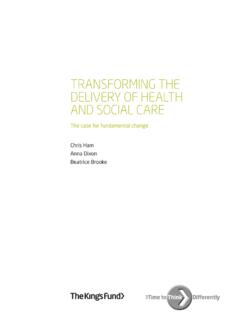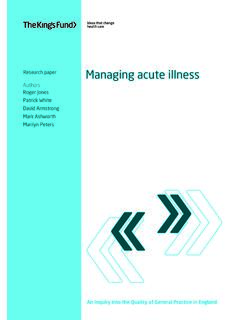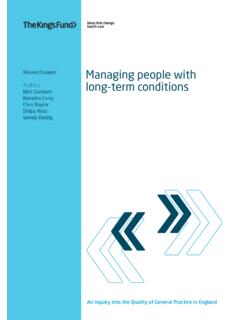Transcription of Understanding quality in district nursing services
1 Understanding quality in district nursing servicesLearning from patients, carers and staffAuthorsJo MaybinAnna CharlesMatthew HoneymanAugust 2016 Contents 1 Understanding quality in district nursing services156342 Contents 1 ContentsKey messages 3 Introduction 5 Background 7 district nursing services 7 Demographic changes and the policy drive to shift care closer to home 10 Managing quality in district nursing services 11 What is good care ? 14A quality framework for district nursing 14 Caring for the whole person 15 Continuity of care 19 The personal manner of staff 23 Scheduling and reliability of appointments 25 Being available for patients and carers to contact between appointments 27 Valuing and involving carers and family members 28 Nurses acting as co-ordinators and advocates 32 Clinical competence and expertise 34 Patient education and support for self-management 36123 Contents 2 Understanding quality in district nursing services156342 What can this model of care achieve?
2 40Is good care consistently being delivered? 41 Pressures in district nursing 42 What gets in the way of good care ? 42 How are services responding to the demand capacity gap in district nursing ? 52 What is the impact on staff wellbeing and the quality and safety of care? 55 What does this mean for district nursing care? 66 Discussion 67 The demand capacity gap: the impact on staff wellbeing and risks to the quality and safety of patient care 67 Knowing when patient care is being damaged 70 Recommendations 72 Appendix: Methodology 76 References 81 About the authors 90 Acknowledgements 91654 Understanding quality in district nursing services156342 Introduction 3 Key messagesDistrict nursing services provide a lifeline for many people and play a key role in helping them to maintain their independence, manage long-term conditions and treat acute illnesses.
3 At their best, they deliver an ideal model of person-centred, preventive and co-ordinated care, which can reduce hospital admissions and help people to stay in their own homes. Although limitations to national data make it difficult to establish a robust account of changes to activity and staffing, there is evidence of a profound and growing gap between capacity and demand in district nursing services . Our research, together with national surveys, indicates that activity has increased significantly over recent years, both in terms of the number of patients seen and the complexity of care provided. While demand for services has been increasing, available data on the workforce indicates that the number of nurses working in community health services has declined over recent years, and the number working in senior district nurse posts has fallen dramatically over a sustained period.
4 Our research suggests that these pressures are compromising quality of care. We found examples of an increasingly task-focused approach to care, staff being rushed and abrupt with patients, reductions in preventive care, visits being postponed and lack of continuity of is having a deeply negative impact on staff wellbeing, with unmanageable caseloads common and some leaving the service as a result. We heard of staff being broken , exhausted and on their knees . It is worrying that the people most likely to be affected by this are often very vulnerable and among those who are also most likely to be affected by cuts in social care and voluntary sector services . It is even more troubling that this is happening behind closed doors in people s homes, creating a real danger that serious failures in care could go undetected because they are quality in district nursing services156342 Key messages 4 district nursing shortages risk adding to pressures on other parts of the health and care system: other recent research by The King s Fund has found this is already having an impact on caseloads in general practice and social care.
5 There is also a risk of this contributing to the growing number of older people requiring acute hospital admission, and to delayed transfers of care for older people being discharged from hospital. The dissonance between the frequently stated policy ambition to offer more care close to home and the apparent neglect of community health services over recent years is striking. Resources, monitoring and oversight remain stubbornly focused on the acute hospital suggest the following as immediate priorities to address the issues revealed in this report: system leaders must recognise the vital strategic importance of community health services in realising ambitions for transforming and sustaining the health and social care system there is an urgent need to create a sustainable district nursing workforce by reversing declining staff numbers, raising the profile of district nursing and developing it as an attractive career robust mechanisms for monitoring resources, activity and workforce must be developed alongside efforts to look in the round at the staffing and resourcing of community health and care services for the older population.
6 It is also essential to develop a robust framework for assessing and assuring the quality of care delivered in community settings. Our research suggests that staff, patients and carers have a strongly aligned set of beliefs about the components of good district nursing care, valuing a whole-person approach to care with a focus on relational continuity, involvement of family and carers, patient education and self-management support, and care co-ordination. This would provide a strong foundation for developing a new quality framework suited to the distinctive characteristics of this 5 Understanding quality in district nursing services5613421 IntroductionDistrict nursing services are a vital part of the NHS for many people, often making the difference between people being able to stay well at home or moving into residential care settings.
7 A growing older population and related increases in the prevalence of frailty and long-term conditions, together with a policy ambition to shift more care out of hospitals and into community settings, mean that district nursing is a key part of the health service both now and in the future (Ham et al 2012). However, we know very little about demand for district nursing services nationally, what capacity there is within the workforce, what level and type of care is provided and still less about the quality of this care. The distinctive features of district nursing care, particularly the fact that it happens behind closed doors in people s homes, make most existing quality measures used in the hospital sector a poor fit and scrutiny a real study focused on care for older people who receive district nursing services in their own homes. It asked the following questions.
8 What does good- quality care look like in this context from the perspective of people receiving care, their carers and district nursing staff ? How does that compare to their experiences? What factors support good care , and what is getting in the way?To answer these questions, we: conducted a review of existing policy and research literature had scoping conversations with national stakeholders conducted focus groups with senior district nursing staff (n=40) carried out interviews with patients, carers and staff in three case study sites (n=50). Introduction 6 Understanding quality in district nursing services561342 Each site was the area covered by one district nursing service.
9 (For details see the Appendix.)While our work was originally focused on drawing together evidence to set out a framework for Understanding the quality of district nursing care, during the course of our research we found evidence of a profound gap between demand and capacity within district nursing services . Moreover, we identified concerning evidence of the impact this was having on staff wellbeing and on the quality and safety of care delivered to patients. Therefore, we present the findings of this report in two parts. The first part sets out our framework for what good care looks like in district nursing services , providing an evidence-based foundation to inform quality assurance and improvement work by frontline teams, provider organisations, commissioners and regulators. The second part outlines evidence of the demand capacity gap in our case study sites together with national data indicating that this is a much wider problem and sets out examples of the ways in which this is damaging staff wellbeing, and pulling care away from the features of good- quality care outlined in our framework.
10 Background 7 Understanding quality in district nursing services2156342 BackgroundDistrict nursing servicesDistrict nursing services deliver a wide range of nursing interventions to people in their own homes (see the box below) and play a key role in supporting independence, managing long-term conditions and preventing and treating acute illnesses. These services are required for many reasons, but are commonly needed by disabled adults, older people living with frailty and long-term conditions, and those who are near the end of their life (Cornwell 2012; Imison 2009). According to the most recent NHS reference costs release for 2014/15 (containing data from just over half of trusts), approximately 20 per cent of NHS spending on community health services was spent on district nursing (about 2 per cent of the total NHS budget) (Department of Health 2015).
